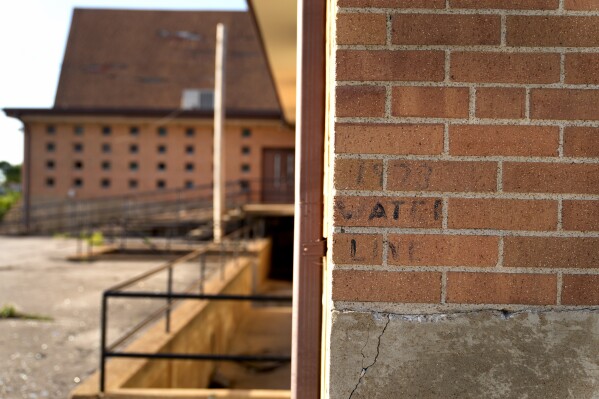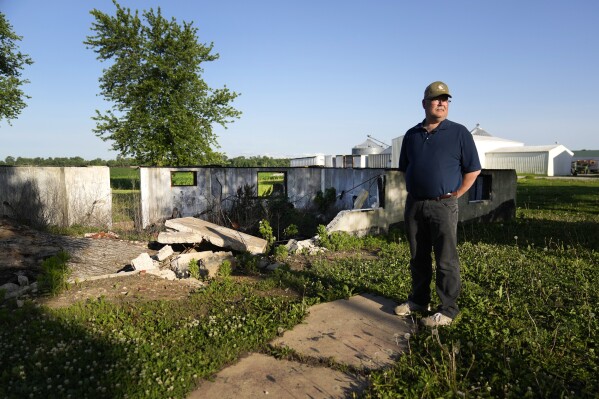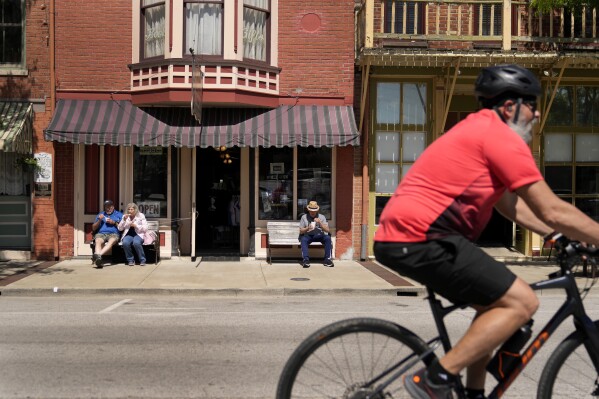Takeaways from AP examination of flooding’s effect along Mississippi River
WEST ALTON, Mo. (AP) — Commerce along the Mississippi River has evolved over the past century at the expense of many once-thriving river towns. But persistent and sometimes devastating flooding has added to the woes of some of those towns.
An examination of data provided to The Associated Press found that flooding pushed people out of their homes along the river at a roughly 30% higher rate than the U.S. as a whole.

The data came from First Street, a risk analysis firm that used modeling that relied on analysis of block-level Census data, flood risk information and other factors. AP further analyzed and mapped the data to find and report on some hard-hit communities.
Here’s what to know from AP’s report:
A changing river valley
Persistent flooding isn’t the only issue that many Mississippi River towns must contend with. Most of them trace their roots to the 19th century, when the mighty river was a convenient way to move heavy goods. Many industries — coal, pulp and paper mills, chemical and metals plants — chose to build alongside the river to take advantage of that.
But technology, automation and consolidation remade all of those. The national highway system gave industries an alternative to river shipping. These things added up to economic headwinds for everyone along the river.
Flooding just makes it all worse. First Street was able to isolate flooding’s effects from other factors that can prod people to move, such as economic decline.

A faded water line marking the height of the 1973 flood is visible on the wall of a damaged and vacant church Wednesday, May 22, 2024, in West Alton, Mo. (AP Photo/Jeff Roberson)
Their data showed that people tend to move to a safer place nearby. But some people leave communities entirely. Older residents are most likely to stay behind. Even in some growing communities, high flood risk constrained that growth.
Dean Klinkenberg, who writes guidebooks and histories of the communities, said it chips away at the river culture as people move away.
What it looks like in one town
West Alton, Missouri, sits on the Mississippi near its meeting with the Missouri River. It had almost 4,000 people in 1970, but major floods in 1973, 1993 and 2019 have left it with fewer than 400.
All three of its churches are gone, and many of the homes still there had to be elevated to stay above future floods.
Mayor Willie Richter said some people just walk away from their homes. He said he probably would have left if he didn’t have such strong community connections.

West Alton Mayor Willie Richter poses for a photo outside what remains of a flood-damaged and burned home Wednesday, May 22, 2024, in West Alton, Mo. (AP Photo/Jeff Roberson)
Sugar Vanburen lost her home in the ’93 flood. She refused to leave, citing the quiet community, good school for her grandchildren and help from neighbors.
But she misses many who have left, and calls West Alton a “ghost town.”
Adapting — and refusing to quit
Recent decades have brought new benefits to some riverside towns, and they’ve taken advantage. The Clean Water Act of 1972 improved rivers and streams around the country that had carried tons of waste. Parks sprouted from cleaned-up industrial areas, attracting tourists and businesses.
One example is Grafton, Illinois, a community of roughly 730 people about an hour north of St. Louis. To cope with bad flooding officials didn’t build a floodwall or levee. Instead, many residents simply vacated risky land to move uphill. Parks on low-lying land can absorb flooding. And the city worked to develop tourist attractions — a winery, a zip line and a marina. The population has edged up in recent years.
And some people love the river so much they won’t leave.

People enjoy ice cream outside a downtown business as a cyclist rides past Wednesday, May 22, 2024, in Hannibal, Mo. (AP Photo/Jeff Roberson)
Steve Dungan lives in Hannibal, Missouri — best known as Mark Twain’s hometown. He and his wife lost most of their stuff when their home was hit by the big flood of 1993. But Dungan came back after that flood, anchored by family and memories.
On a recent day, Dungan biked to his mother’s tidy white frame home near the creek.
“Dad passed away in this house,” he said. “Mom lives here. I’ve got an older brother in this room, and he’s handicapped. So, no.”

A child runs past an opening in the flood wall protecting downtown Hannibal, Mo., Wednesday, May 22, 2024. (AP Photo/Jeff Roberson)
___
The Associated Press receives support from the Walton Family Foundation for coverage of water and environmental policy. The AP is solely responsible for all content. For all of AP’s environmental coverage, visit https://apnews.com/hub/climate-and-environment
Disclaimer: The copyright of this article belongs to the original author. Reposting this article is solely for the purpose of information dissemination and does not constitute any investment advice. If there is any infringement, please contact us immediately. We will make corrections or deletions as necessary. Thank you.






